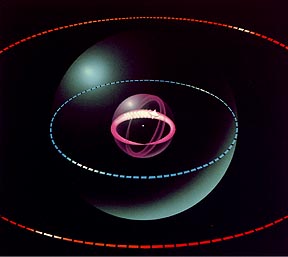- Its mass, revolving in orbit, creates a top-like angular momentum which gives the whole orbit a stabilizing force.
- The electrostatic charge is evenly distributed over the pathway as if the entire circle were a homogenous cloud of negative electricity.
- The moving electrostatic charge causes the orbit to become a dipole magnetic field like a current-loop. The faster the electron completes its cycle, the greater is its orbital magnetism.
- The spin magnetic field is also smeared throughout the orbit, overlaying a second magnetic field on the orbital one. Spin can point in the same direction or in the direction opposite to the orbital field.
- The matter-wave itself acts as a force since it has the capacity to resist intersection from other electrons’ matter-waves.
- With this set of properties, each electron within the atom is able to interact with other atomic electrons. As pseudo-objects, these matter-wave orbits perform in the manner of real electro-magnetic-mechanical items.
|
 |